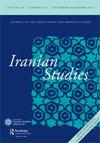Iran Protests and Patterns of State Repression
IF 0.9
4区 社会学
Q2 AREA STUDIES
引用次数: 0
Abstract
Over the past four months, the brutal, extralegal, and violent repression of protestors during the Woman, Life, Freedom movement in Iran has taken observers and participants by devastating and sometimes fatal surprise. Although not a drastic departure from past practices, the large scale and seemingly random acts of violence, such as the beating of protestors to death on the streets, the shooting of passersby and nonviolent demonstrators point blank, and the fatal torturing of detained protestors and activists, have marked new levels and scales of violence. In what follows I analyze this brutal repression campaign in relation to the institutional history of the Islamic Republic's armed units, particularly the Islamic Revolutionary Guards Corps (IRGC) as the most controversial entity among all. I contend that the IRGC's historic endorsement of firing at will as an accepted practice among its ranks has enabled the decentralized radical instances of violence. I will discuss how, despite the continued reliance on decentralized forces, their firing at will is not unanimously endorsed this time around, due to the different nature of the current movement and the deepening uncertainties and schisms in both the forces on the ground and the ruling elite.伊朗的抗议和国家镇压模式
在过去的四个月里,在伊朗的妇女、生命、自由运动中,对抗议者的残酷、法外和暴力镇压使观察员和参与者感到毁灭性的,有时甚至是致命的意外。尽管与过去的做法没有太大的不同,但大规模和看似随意的暴力行为,如在街头殴打抗议者,近距离射杀路人和非暴力示威者,以及对被拘留的抗议者和活动人士进行致命的折磨,标志着暴力的新水平和规模。在接下来的文章中,我分析了这场残酷的镇压运动与伊斯兰共和国武装部队的制度历史的关系,特别是伊斯兰革命卫队(IRGC)是所有实体中最具争议的实体。我认为,伊斯兰革命卫队历来支持随意开火,这在其队伍中是一种被接受的做法,这使得分散的激进暴力事件得以发生。我将讨论,尽管继续依赖分散的力量,但由于当前运动的不同性质,以及地面力量和统治精英之间不断加深的不确定性和分裂,他们的随意射击这次并没有得到一致认可。
本文章由计算机程序翻译,如有差异,请以英文原文为准。
求助全文
约1分钟内获得全文
求助全文
来源期刊

Iranian Studies
Multiple-
自引率
0.00%
发文量
92
期刊介绍:
Iranian Studies is a peer-reviewed journal devoted to Iranian and Persian history, literature, and society, published on behalf of the Association for Iranian Studies . Its scope includes all areas of the world with a Persian or Iranian legacy, especially Iran, Afghanistan, Central Asia and the Caucasus, and northern India, and Iranians in the diaspora. It welcomes submissions in all disciplines.
 求助内容:
求助内容: 应助结果提醒方式:
应助结果提醒方式:


